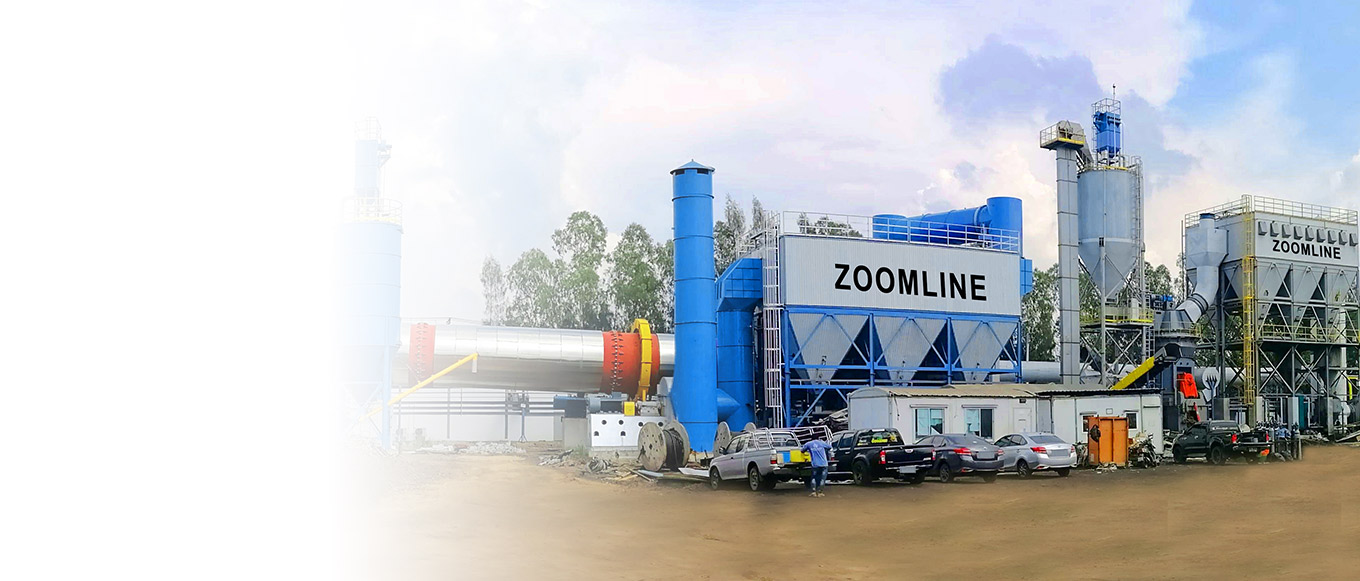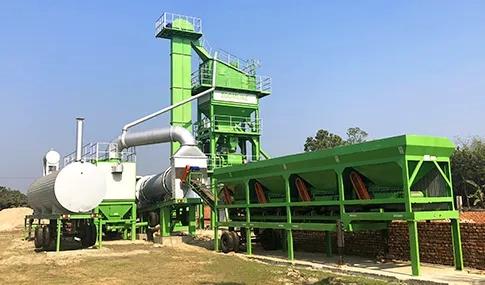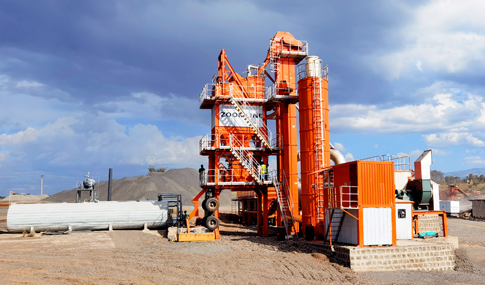The Importance of Asphalt Mixture Quality Control
The core role of asphalt mixtures in road construction
Asphalt mixtures, as the core material for road construction, directly determine the load-bearing capacity, driving comfort, and service life of roads. In modern transportation networks, whether it’s highways, urban arterial roads, or rural roads, asphalt pavements dominate due to their excellent smoothness, skid resistance, and ease of repair. High-quality asphalt mixtures can effectively resist the repeated impacts of vehicle loads, the erosion of extreme weather, and fatigue wear from long-term use. Conversely, quality defects can lead to pavement problems such as cracks, ruts, and loosening, not only increasing maintenance costs but also potentially causing traffic safety hazards. Therefore, the quality level of asphalt mixtures has become a key indicator for measuring the quality of transportation infrastructure construction.
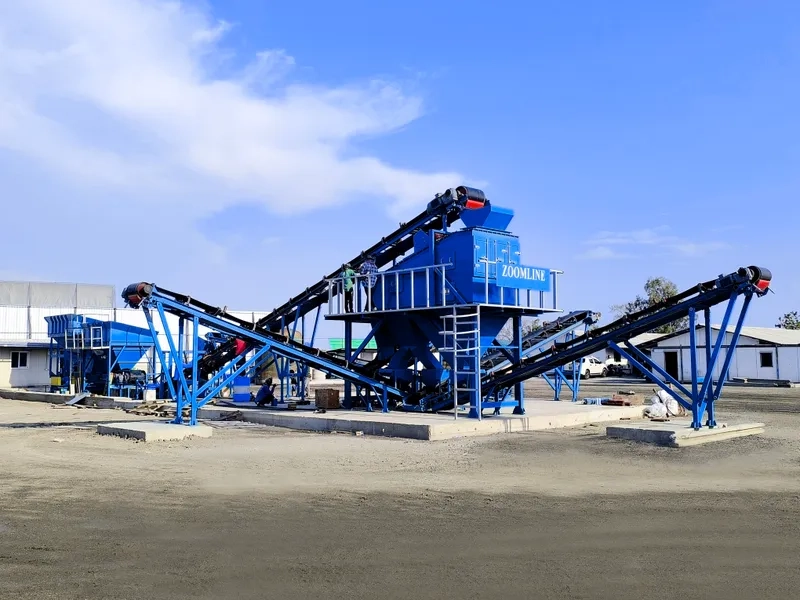
Overall Framework for Quality Control and Assurance
Asphalt mixture quality control and assurance is a comprehensive lifecycle system that spans raw material procurement, mixture design, production and processing, construction and paving, and subsequent operation and maintenance. This framework, based on the core principles of “prevention first, process control, and result verification,” encompasses seven core aspects: raw material inspection, mixture design optimization, production plant calibration, continuous quality monitoring, on-site testing and verification, quality assurance agreements, and long-term performance evaluation. It is further supported by a robust system including supplier management, technological innovation, and equipment maintenance. Each aspect is interconnected, forming a closed-loop management mechanism of “source control—process precision control—result assurance—continuous improvement,” ensuring that every batch of asphalt mixture meets established standards.
Key Principles for Achieving Excellent Quality
Achieving superior quality in asphalt mixtures requires adhering to three core principles: First, the principle of standard guidance, strictly adhering to national, industry, and project-specific technical standards, and clearly defining quality requirements and testing methods at each stage; second, the principle of system collaboration, strengthening coordination among production, construction, and testing departments to ensure smooth information transmission and effective accountability; and third, the principle of continuous improvement, relying on data accumulation and technological innovation to continuously optimize processes and quality control strategies. These three principles together constitute the cornerstone of asphalt mixture quality control, guiding quality management towards precision and efficiency.
Raw Material Inspection: The Foundation of Quality Assurance
Raw materials are the “innate genes” of asphalt mixture quality, directly determining the upper limit of subsequent product performance. Therefore, it is essential to establish a strict raw material inspection mechanism, conduct comprehensive screening of key components such as aggregates, binders, and additives, and strengthen supplier management to build a solid quality defense line from the source.
Inspection Standards for Aggregates
Aggregates account for more than 90% of asphalt mixtures, and their physical and mechanical properties have a decisive influence on the stability, strength and durability of the mixture. They need to be tested from multiple dimensions such as gradation, moisture content and strength.
Gradation Analysis
Aggregate gradation refers to the proportion of particles of different sizes, which directly affects the porosity, density, and workability of the mixture. Testing requires sieving, where aggregates are graded and screened using standard sieves to create a gradation curve, ensuring it meets the continuous or discontinuous gradation requirements of the project design. For heavy-load pavements such as highways, aggregate gradation is typically required to be concentrated in the median range to reduce segregation; while for light-load pavements such as rural roads, the standard range can be appropriately relaxed, but the gradation curve must be smooth without abrupt changes.
Moisture content testing
Excessive moisture content in aggregates reduces the bond strength between asphalt and aggregates, and also affects the mixing temperature and compaction effect of the mixture. The testing method uses a drying process, where aggregate samples are placed in an oven at 105℃±5℃ and dried to constant weight. The moisture content is calculated based on the difference in mass before and after drying. Generally, the moisture content of coarse aggregates should not exceed 1%, and the moisture content of fine aggregates should not exceed 3%. If these standards are exceeded, sun-drying or oven-drying treatment is required to ensure stable moisture content before use.
Strength and Durability Assessment
Strength assessment is primarily achieved through crushing value and abrasion value tests: the crushing value test determines the aggregate’s resistance to crushing under gradually increasing loads; the crushing value of coarse aggregate for highways must be ≤26%. The abrasion value test, conducted using a Los Angeles abrasion tester, measures the aggregate’s resistance to friction and impact; its abrasion loss should be ≤28%. Durability assessment is performed through a soundness test, utilizing the crystallization expansion effect of sodium sulfate solution to examine the aggregate’s resistance to freeze-thaw cycles and chemical erosion; the soundness loss rate must be ≤8% to ensure that the aggregate does not significantly deteriorate during long-term use.
Chemical composition analysis of the adhesive
Asphalt binder is the core component that binds aggregate particles together. Its performance mainly depends on its chemical composition and physical properties, and it is necessary to focus on testing viscosity, softening point and compatibility.
Viscosity and softening point test
Viscosity reflects the flow resistance of asphalt at a given temperature, directly affecting the mixing difficulty and paving performance of the mixture. The viscosity of asphalt at 60℃ and 135℃ is determined using a Brookfield rotational viscometer. The viscosity at 60℃ is used to assess the high-temperature stability of asphalt, while the viscosity at 135℃ guides mixing temperature control. The softening point is the critical temperature at which asphalt transitions from a solid to a viscous flow state. It is determined using the ring and ball method. Generally, asphalt used for highways is required to have a softening point ≥45℃ to ensure that the pavement does not rut during high summer temperatures.
Compatibility Verification
Compatibility refers to the bonding stability between asphalt and aggregates and additives. Poor compatibility can lead to problems such as spalling and loosening of the mixture. Verification is performed using either the boiling water method or the immersion water method: the boiling water method involves placing asphalt-coated aggregate particles in boiling water for 3 minutes and observing the degree of asphalt film spalling; the immersion water method involves immersing the sample in 25°C water for 48 hours and then measuring the adhesion strength. The acceptable standard is an asphalt film spalling area ≤10%. For damp areas or rainy road sections, additional anti-stripping agents are required to improve compatibility.
Performance review of additives
Additives, as functional components that improve the performance of asphalt mixtures, include anti-stripping agents, modifiers, and anti-aging agents. Their performance must be matched with the application scenarios of the mixture, with a focus on reviewing their stability and environmental adaptability.
Stability Impact Assessment
To evaluate the effect of additives on improving the high-temperature stability and low-temperature crack resistance of the mixture: For modifiers (such as SBS and SBR), it is necessary to measure the penetration and ductility of the asphalt after addition. The ductility (5℃) of SBS modified asphalt should be ≥50cm. For anti-stripping agents, the splitting strength ratio (TSR) of the mixture should be determined by freeze-thaw splitting test. The TSR should be ≥80% to ensure that the mixture maintains sufficient strength after freeze-thaw cycles.
Environmental adaptability check
Based on the climate characteristics of the project area, the environmental adaptability of the additives should be examined: for projects in cold regions, the focus should be on verifying the effect of additives on improving the low-temperature crack resistance of the mixture, measured by low-temperature bending tests, with a failure strain requirement of ≥2500με; for high-temperature regions, the improvement of high-temperature stability by additives should be evaluated, measured by dynamic stability tests (DS), with a DS value of ≥3000 cycles/mm. Simultaneously, it must be confirmed that the additives do not contain environmentally harmful components and comply with environmental standards.

Supplier Management Mechanism
A stable supply of high-quality raw materials is inseparable from standardized supplier management. It is necessary to establish a full-process management system of “selection-audit-cooperation-traceability” to ensure that the quality of raw materials is controllable.
Supplier Selection and Audit
Supplier selection requires a comprehensive evaluation of their production qualifications, technical capabilities, quality reputation, and supply capacity, with priority given to companies certified under the ISO 9001 quality management system. Regular supplier audits are conducted, including on-site inspections of production equipment, inspection processes, and quality control systems, as well as review of raw material testing reports and production records. Suppliers failing audits are given a deadline for rectification or are eliminated to ensure they have the ability to continuously provide qualified raw materials.
Establishment of Long-Term Cooperative Relationships
Establish long-term strategic partnerships with high-quality suppliers to enhance supply chain stability through long-term supply agreements, shared quality standards, and technological cooperation. Establish supplier incentive mechanisms, rewarding suppliers with stable quality and high cooperation with preferential pricing and priority ordering, forming a cooperative model of “shared benefits and shared risks” to avoid raw material quality fluctuations caused by frequent supplier changes.
Raw Material Traceability System
Establish a raw material traceability system, assigning a unique identifier to each batch of raw materials and recording data such as supplier information, production date, inspection report, warehousing time, and usage destination. When quality issues arise, the traceability system can quickly locate the problematic batch of raw materials, identify the responsible party, and promptly implement isolation and recall measures to prevent the problem from spreading. The traceability system data must be stored long-term to provide a basis for quality analysis and improvement.
Hybrid Design Optimization: Performance Customization
Hybrid design is the core step in transforming qualified raw materials into high-performance asphalt mixtures. It requires scientific calculation and experimental optimization based on the project’s traffic conditions, climate characteristics, and road surface type to determine the optimal material ratio and achieve customized matching of mixture performance.
Comprehensive consideration of influencing factors
Hybrid design optimization should be guided by actual usage scenarios, and comprehensively analyze key influencing factors such as traffic load, climate conditions, and road surface application types to ensure the relevance and applicability of the design scheme.
Traffic Load Analysis
Traffic load is a core factor determining the strength and durability of asphalt mixtures. Traffic surveys are needed to clarify parameters such as average daily traffic volume, axle load distribution, and the proportion of heavy-duty vehicles for the designed lanes. An equivalent axle load conversion method is used to convert the axle loads of different vehicle types to standard axle loads (BZZ-100) and calculate the cumulative equivalent axle loads. For highways with a cumulative equivalent axle load exceeding 10 million loads, modified asphalt mixtures should be used, with increased aggregate strength and binder content. For rural roads with a cumulative equivalent axle load below 1 million loads, ordinary asphalt mixtures can be used, appropriately reducing costs.
Climate Condition Assessment
Climate conditions directly affect the temperature stability of asphalt mixtures, and the design must be based on climatic parameters such as the annual extreme maximum temperature, extreme minimum temperature, and rainfall of the project area. In high-temperature regions, it is necessary to focus on improving the high-temperature rutting resistance of the mixture by using high-viscosity asphalt or adding fiber stabilizers to reduce the porosity of the mixture. In cold regions, it is necessary to strengthen the low-temperature crack resistance by selecting asphalt with high ductility and increasing the proportion of fine aggregate to improve flexibility. In humid and rainy regions, it is necessary to focus on improving water stability by adding anti-stripping agents and optimizing the gradation to increase density.
Selection of Road Surface Application Type
Different pavement structural layers (top layer, middle layer, and bottom layer) have different functional requirements, and hybrid designs need to be adjusted accordingly. The top layer directly bears vehicle wear and climate erosion, and needs to have excellent skid resistance, smoothness, and aging resistance. It usually uses fine-grained asphalt mixture (AC-13C) and selects wear-resistant aggregates. The middle layer, as a load-bearing layer, needs to have high strength and stability, and uses medium-grained asphalt mixture (AC-20C). The bottom layer mainly plays a connecting role between the top and bottom layers, and needs to have good load-bearing capacity and drainage. It can use coarse-grained asphalt mixture (AC-25C).
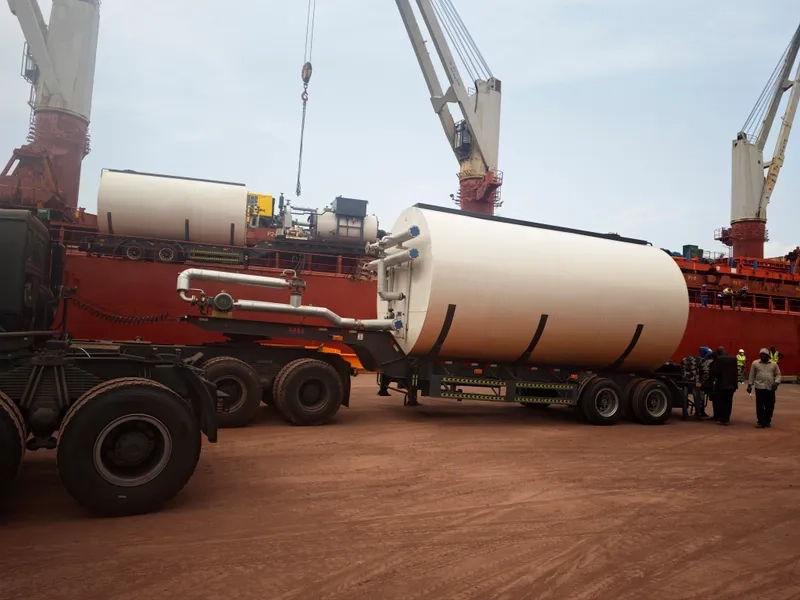
Application of Advanced Modeling Tools
With the development of information technology, advanced modeling tools have become an important support for hybrid design optimization, enabling accurate prediction of mixture performance through simulation analysis and achieving efficient optimization of design schemes.
Use of simulation software
Asphalt mixture performance simulation software (such as UTM and MARS) is used to construct microstructural models of the mixtures, simulating their high-temperature deformation, low-temperature cracking, and water damage under different mix proportions. By inputting basic data such as aggregate gradation, asphalt properties, and additive parameters, the software can output key performance indicators such as dynamic stability, low-temperature flexural strain, and freeze-thaw splitting strength ratio, providing a quantitative basis for mix proportion optimization. For example, MARS software can be used to simulate the effect of different SBS modifier dosages on the high-temperature performance of the mixture, quickly determining the optimal dosage ratio.
Balance between durability and flexibility
Balancing durability and flexibility is a core challenge in hybrid design, and advanced modeling tools can achieve this coordination through multi-objective optimization algorithms. The software analyzes the relationship between the porosity of the mixture and the asphalt film thickness, ensuring a porosity ≤4% (improving durability) while maintaining an asphalt film thickness ≥6μm (ensuring flexibility). By simulating stress-strain curves under fatigue loading, it optimizes aggregate gradation and asphalt content to ensure the mixture’s fatigue life meets design requirements (typically ≥1 million cycles).
Strategy for Adjusting the Proportioning Formula
Adjustments to the mixing formula must follow the process of “experimental verification – data analysis – iterative optimization”, with performance test results as the core basis to achieve continuous improvement of the mixing scheme.
Performance-based testing methods
Abandoning the traditional “volume index-oriented” design, a performance-based testing method is adopted, using performance indicators such as dynamic stability (DS), low-temperature flexural strain (εB), and freeze-thaw splitting strength ratio (TSR) as core standards for mix design qualification. For example, for highway surface layer mixtures, the requirements are DS≥3000 cycles/mm, εB≥2500με, and TSR≥85%. If any indicator fails to meet the standard, the asphalt content, aggregate gradation, or additive dosage must be adjusted, and the test must be repeated for verification.
Iterative Optimization Process
Establish an iterative optimization process of “initial mix design – testing – adjustment – retesting”: First, determine the initial mix proportion (e.g., asphalt content 4.5%~5.5%) based on empirical formulas, and prepare Marshall specimens for volumetric index testing (void ratio, aggregate void ratio, etc.); then, conduct performance tests on qualified specimens. If the performance indicators do not meet the standards, adjust the problematic aspects (e.g., increase asphalt viscosity if high-temperature performance is insufficient, increase the proportion of fine aggregate if low-temperature performance is insufficient); repeat the above process until all performance indicators meet the design requirements, and finally determine the optimal mix proportion formula.
Production Plant Calibration: Ensuring Batch Consistency
The production process of asphalt mixtures is a crucial step in transforming design schemes into actual products. The precision and operational stability of the equipment in the production plant directly affect the batch consistency of the mixtures. It is necessary to establish strict equipment calibration procedures, adhere to industry standards, and strengthen batch production monitoring to ensure that each batch of mixtures meets design requirements.
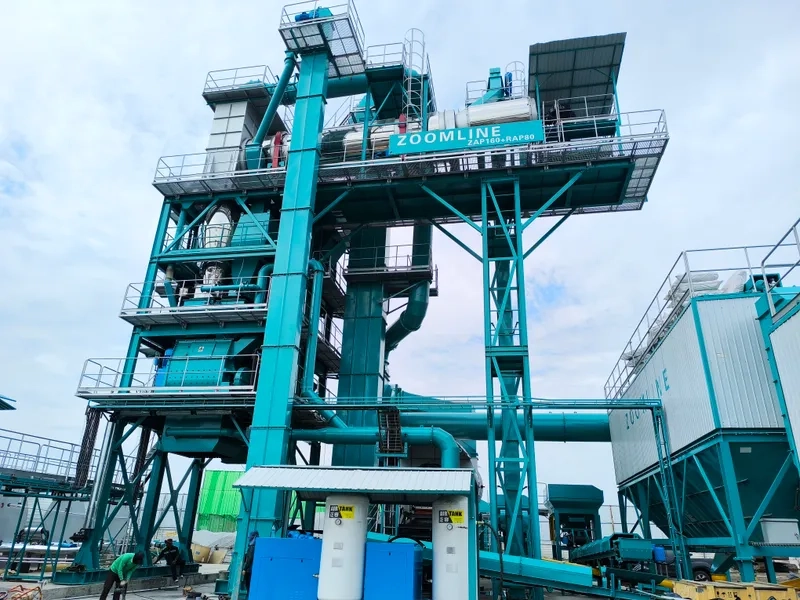
Equipment Calibration Procedure
The accuracy of production equipment is the foundation for ensuring stable mixing ratios. It is necessary to regularly calibrate and verify key equipment such as temperature control systems and mixing units to eliminate equipment errors.
Temperature Control System Validation
Temperature is a core control parameter in asphalt mixture production; excessively high or low temperatures will affect the mixture’s performance. The aggregate drying temperature, asphalt heating temperature, and mixture discharge temperature are calibrated weekly using a standard thermometer to ensure that the drying temperature error is ≤ ±5℃, the asphalt heating temperature error is ≤ ±3℃, and the discharge temperature error is ≤ ±5℃. For continuous mixing equipment, the temperature must be measured three times at different times each shift, and temperature change curves must be plotted. If the fluctuation exceeds ±10℃, the machine must be stopped to check the burner and temperature control system, and any faults should be rectified promptly.
Accuracy Adjustment of Hybrid Unit
The accuracy of the batching unit directly determines the accuracy of the mixture proportions. Therefore, the aggregate batching scale, asphalt metering pump, and additive metering device must be calibrated monthly. Standard weights are used to calibrate the batching scale, ensuring that the aggregate batching error is ≤±1%, the asphalt metering error is ≤±0.3%, and the additive metering error is ≤±0.1%. After calibration, trial production is conducted, and three different batches of mixture samples are taken for gradation and asphalt content testing. If the test results deviate from the design values beyond the allowable range, the parameters of the batching system must be readjusted until the accuracy meets the standards.
Compliance with Industry Standards
The production process must strictly adhere to international and domestic industry standards, integrating the standard requirements into all aspects of production to ensure that the quality of the mixture meets the specifications.
Key Points for Implementing ASTM Standards
Referring to relevant standards from the American Society for Testing and Materials (ASTM), the following requirements should be emphasized: ASTM D6926 specifies the temperature range for the production and paving of asphalt mixtures, and the optimal temperature must be determined based on the asphalt grade (e.g., the mixing temperature for No. 70 asphalt is 150℃~170℃); ASTM D1559 specifies the Marshall stability test method, requiring a Marshall test every 2000 tons of mixture during production to ensure stability ≥8kN and flow value within the range of 1.5mm~4.0mm. Simultaneously, ASTM standards should be combined with the actual needs of the project to develop targeted production operation guidelines.
Integration of National and Technical Standards
We strictly adhere to national standards such as the “Technical Specification for Construction of Asphalt Pavement on Highways” (JTG F40-2004), integrating the requirements of these standards with our company’s technical standards to form a production control system. For example, the specifications require that the storage time of hot-mix asphalt mixtures not exceed 72 hours. During production, a registration system for the entry and exit of mixtures must be established, and the performance of mixtures stored beyond the expiration date must be re-tested. If the mixture fails to meet the requirements, it must be prohibited from use. The specifications also set forth clear requirements for the control of segregation in mixtures. During production, we need to optimize the design of silos, use spiral distributors to reduce aggregate segregation, and install anti-segregation devices at the discharge outlet.
Batch Production Monitoring
Establish a batch production process monitoring mechanism to promptly identify and correct deviations in the production process, ensuring the stable quality of each batch of mixture.
Uniformity Detection Indicators
Uniformity is a core indicator for measuring batch quality consistency. Three samples of each batch of mixture must be taken at different times from the discharge port to test indicators such as gradation, asphalt content, and Marshall stability. If the gradation deviation of the same batch of samples is ≤2%, the asphalt content deviation is ≤0.3%, and the stability deviation is ≤10%, then the uniformity is considered合格 (qualified). If the deviations exceed the specified range, the cause must be analyzed (e.g., batching system malfunction, insufficient mixing time, etc.), and the entire batch of mixture must be inspected. Any batch that fails to meet the standard must be scrapped.
Deviation Correction Mechanism
Establish a real-time production deviation correction mechanism. The production control system collects data such as ingredient quantities, temperature, and mixing time in real time. When the data exceeds the standard range, the system automatically issues an alarm and suspends production. Technical personnel must immediately investigate the cause of the deviation: if it is due to equipment inaccuracy, timely calibration is performed; if it is due to operational errors, the operating procedures are standardized; if it is due to raw material fluctuations, the mixing formula is readjusted. After deviation correction, trial production is required. Normal production can only resume after the sample passes inspection. Simultaneously, the cause of the deviation and the corrective measures are recorded to create a production improvement file.

Continuous Quality Monitoring: Real-time Dynamic Management
Quality control of asphalt mixtures is not a one-time inspection, but a dynamic management process that runs through the entire production process. It requires the use of real-time monitoring technology to continuously track key parameters during production, promptly identify deviations, and take intervention measures to ensure that quality remains under control at all times.
Key Parameter Tracking
Focusing on the core parameters affecting the quality of the mixture, a multi-dimensional monitoring system is established to achieve precise control of the production process.
Temperature and Viscosity Monitoring
Temperature sensors are installed at the aggregate drying drum outlet, asphalt storage tank, mixing cylinder, and discharge port to collect temperature data in real time and transmit it to the central control system. The temperature data is updated every 10 seconds. When the temperature exceeds the set range (e.g., mixing temperature ±5℃), the system immediately triggers an audible and visual alarm. Simultaneously, an online viscometer is installed on the asphalt conveying pipeline to monitor asphalt viscosity changes in real time. When viscosity fluctuations exceed ±10%, the asphalt heating temperature is automatically adjusted to ensure stable asphalt performance.
Real-time detection of adhesive content
The binder content in the mixture is monitored in real time using a microwave sensor or nuclear density meter. Twenty data points are continuously measured for each batch of mixture, and the average and standard deviation are calculated. If the binder content deviation exceeds ±0.3%, the system automatically adjusts the flow rate of the asphalt metering pump for real-time correction. For modified asphalt mixtures, the modifier dosage needs additional monitoring using infrared spectroscopy to ensure that the modifier dosage meets design requirements (e.g., SBS modifier dosage is 3%~5%).
Deviation Identification and Adjustment
Establish a deviation handling process of “alarm-investigation-intervention-verification” to ensure that deviations are handled in a timely and effective manner.
Alarm System Settings
A multi-level alarm mechanism is set up based on the importance of parameters: Level 1 alarm (parameter deviation ≤ 5%) requires on-site investigation by the operator, who records the handling process; Level 2 alarm (parameter deviation 5%~10%) suspends production of that batch, and technical personnel intervene to analyze the cause; Level 3 alarm (parameter deviation ≥ 10%) triggers an emergency shutdown and activates the quality incident emergency plan. Alarm information must be simultaneously pushed to the production management platform to ensure that relevant personnel respond immediately.
Immediate Intervention Measures
Standardized intervention measures are developed for different types of deviations: For temperature deviations, if the aggregate temperature is too low, adjust the burner power; if the asphalt temperature is too high, lower the heating device temperature and increase the conveying speed. For binder content deviations, if the content is too high, reduce the asphalt metering pump flow rate and appropriately increase the aggregate dosage; if the content is too low, increase the asphalt flow rate and check for blockages in the asphalt conveying pipeline. After intervention, samples should be taken for performance testing to verify the intervention effect and ensure that the parameters return to the standard range.
Analysis and Recording of Monitoring Data
Monitoring data is an important basis for quality analysis and continuous improvement. A standardized data management system needs to be established to achieve effective use of the data.
Data Visualization Tools
Big data analytics platforms (such as Tableau and Power BI) are used to visualize monitoring data, generating temperature change curves, binder content fluctuation graphs, and performance indicator trend charts to intuitively present quality fluctuations during the production process. Through comparative data analysis, quality differences across different time periods and equipment are identified, providing direction for equipment maintenance and process optimization. For example, if analysis reveals that the mixture produced by a certain mixing tank has low stability, the wear of the mixing blades in that tank can be specifically checked.
Trend Prediction Model
Based on historical monitoring data, a quality trend prediction model is constructed, and machine learning algorithms (such as neural networks and regression analysis) are used to predict the quality indicators of future production batches. When the model predicts that a certain parameter may exceed the standard range, an early warning is issued, allowing technicians to adjust production parameters in advance to achieve “prevention.” For example, by analyzing the correlation between ambient temperature and the discharge temperature of the mixture, a predictive model is established. When the ambient temperature drops by 5°C, the temperature of the heating device is increased in advance to avoid the discharge temperature being too low.
On-site testing: Construction verification phase
The quality of asphalt mixtures ultimately needs to be verified during construction. On-site testing is a crucial step in verifying the workability and final quality of the mixture. Comprehensive tests must be conducted on compaction effects, structural dimensions, and performance characteristics to ensure that the construction quality meets design requirements.
Compacted density check
Compaction density directly affects the strength, stability, and durability of asphalt pavement. It is a core indicator in field testing and requires scientific testing methods and strict qualification standards.
Test Equipment and Methods
A combined testing method using nuclear density metering and core drilling is employed: the nuclear density meter is used for rapid detection, with one point tested every 200 square meters, and the results displayed instantly; the core drilling method is used for precise verification, with one core sample drilled every 1000 square meters and sent to the laboratory for density determination. During testing, it is essential to ensure that the nuclear density meter is calibrated, and that core sampling locations avoid road joints and damaged areas. After sampling, any holes should be promptly filled to prevent moisture infiltration.
Definition of Qualification Standards
The acceptable compaction density is determined based on the type of mixture and the pavement layer: for highways, the compaction degree of the surface layer must be ≥98% (based on Marshall density), and the middle and lower layers ≥97%; for Class I highways, the surface layer must be ≥97%, and the middle and lower layers ≥96%. If the nuclear density meter test result is lower than the standard value, it must be immediately verified using the core drilling method. If it is confirmed to be unqualified, the pavement in that area must be reworked, repaved, and compacted until the density meets the standard.
Thickness and Core Sample Verification
Road thickness is an important indicator for ensuring load-bearing capacity, while core sample verification can comprehensively evaluate the construction quality and structural integrity of the mixture.
On-site sampling procedure
The pavement thickness test employs the core drilling method, with the sampling frequency consistent with that of the compaction density test. Each core sample requires thickness measurements at three different locations, and the average value is taken as the thickness value at that point. A dedicated core drilling machine must be used during sampling to ensure the core sample is intact and undamaged, with a height ≥10cm (for the upper layer). After sampling, the sampling location, thickness data, and appearance characteristics are recorded, and a core sample file is established.
Structural Integrity Assessment
The structural integrity is assessed through visual observation and performance testing of core samples: Visually, there should be no defects such as looseness, segregation, or cracks, and the asphalt film should be uniformly applied. Performance tests include indicators such as Marshall stability and porosity, and the results must be consistent with those obtained during production. If the core sample is loose or has an excessively high porosity (≥6%), it indicates insufficient compaction or quality problems with the mixture, requiring tracing back to the production and construction stages and implementing additional compaction or rework measures.
Anti-skid performance evaluation
Anti-skid performance is a key indicator for ensuring driving safety, especially in rainy or snowy weather, and scientific testing is needed to ensure that the road surface has sufficient friction resistance.
Measurement of friction coefficient
Anti-skid performance was tested using a pendulum friction coefficient measuring instrument or a side force coefficient testing vehicle (SFC). The pendulum instrument was used for fixed-point testing, with one test point every 500m, and the test temperature was 20℃±2℃. The SFC was used for continuous testing, with a test speed of 50km/h and 100 data points recorded per kilometer. The test results need to be converted to the friction coefficient at standard temperature. The pendulum friction coefficient (BPN20) for the surface layer of highways needs to be ≥45, and the SFC value needs to be ≥55.
Security Performance Optimization
If the skid resistance performance fails to meet the standards, the cause must be analyzed and optimization measures taken: if the aggregate polishing value is insufficient, replace it with wear-resistant aggregate (such as basalt); if over-compaction causes the aggregate to embed too deeply, adjust the compaction process, reduce the roller tonnage, or reduce the number of compaction passes; if poor road surface smoothness leads to localized insufficient skid resistance, use precision milling technology to repair the road surface. For dangerous road sections such as sharp bends and steep slopes, the skid resistance performance standards need to be improved to ensure driving safety.
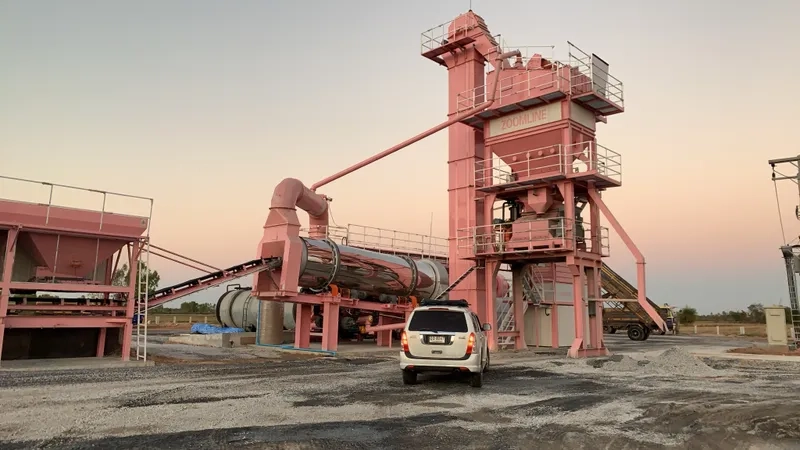
Quality Assurance Agreement: Comprehensive Certification System
The quality assurance agreement is a system guarantee that ensures the quality of asphalt mixtures is controllable throughout the entire process from production to construction. Through document management, team collaboration, and external certification, a comprehensive quality certification system is built to provide double assurance for quality.
Document Management Process
Documentation management is the foundation for quality traceability and accountability. A document system covering the entire process needs to be established to ensure information integrity and traceability.
Compliance with contract specifications
Production and construction must be carried out strictly in accordance with the quality specifications in the project contract. Performance indicators, testing methods, and acceptance standards from the contract must be translated into internal control documents, clearly defining quality responsibilities at each stage. For example, if the contract stipulates that the low-temperature flexural strain of the mixture is ≥2500με, this indicator must be included in the performance testing scope during production, and the test report must clearly indicate whether it meets the contract requirements. Regular contract compliance reviews must be conducted to ensure that production and construction are consistent with contract specifications.
Information Flow Mechanism
A comprehensive information flow mechanism has been established, encompassing production, testing, construction, and acceptance, with real-time data sharing achieved through an information management platform. The production department promptly uploads raw material inspection reports and production parameter records; the testing department uploads performance test data; the construction department uploads on-site test results; and the acceptance department compiles data from each stage to form the final acceptance report. This information flow adheres to the principle of “whoever generates, uploads, and is responsible,” ensuring data authenticity, accuracy, and timeliness, thus supporting the rapid identification of quality issues.
Team Collaboration Mode
Quality control is not the responsibility of a single department; it requires strengthened collaboration among multiple departments, including production, construction, and testing, to form a joint force for quality management.
Production and Construction Coordination
Establish a regular communication mechanism between the production and construction departments, holding weekly coordination meetings to report on production plans, asphalt mixture performance indicators, and construction progress. The production department adjusts production parameters (such as mixing temperature and asphalt dosage) promptly based on feedback from the construction department regarding paving workability and compaction effects. The construction department, in turn, rationally schedules paving times based on the production department’s capacity to avoid performance degradation caused by prolonged storage of the mixture. For large-scale projects, establish on-site technical service points with production technicians permanently stationed at the construction site to resolve quality issues in real time.
Cross-departmental communication channels
Establish cross-departmental communication channels, including online communication platforms (such as WeChat Work and DingTalk) and offline communication meetings. Set up a dedicated hotline for quality issue feedback, allowing construction personnel to report on-site quality problems at any time; the testing department should promptly provide test results to the production and construction departments and propose improvement suggestions; the management department should regularly organize quality analysis meetings to summarize issues from various departments and formulate improvement measures. Through smooth communication channels, ensure information symmetry among departments and form a collaborative mechanism of “identifying problems—analyzing causes—solving problems”.
External Certification and Audit
External certification and auditing are important means of verifying the effectiveness of a quality control system. Through the evaluation and supervision of third-party organizations, the level of quality control can be improved.
ISO 9001 Certification Process
Actively promote ISO 9001 quality management system certification and establish a comprehensive quality management system covering the entire process from raw material procurement and production to product testing and after-sales service, in accordance with certification requirements. The certification process includes system planning, document preparation, internal audits, management reviews, and third-party audits. After certification, strictly adhere to system requirements, conduct regular internal audits and management reviews to ensure the system’s continued effective operation. ISO 9001 certification not only enhances a company’s quality control capabilities but also strengthens customer trust in product quality.
Regular Internal Audit Plan
Establish a regular internal audit plan, conducting two comprehensive internal audits annually and one special audit quarterly (such as a special audit of raw material inspection or a special audit of the production process). Auditors are composed of professionally qualified personnel who employ methods such as sampling inspection, on-site verification, and data comparison to assess the implementation of the quality control system. Upon completion of the audit, an audit report is generated, clearly identifying existing problems, responsible departments, and rectification deadlines, and tracking the implementation of corrective measures to form a closed-loop audit management system. Through internal audits, system loopholes are identified promptly, and quality control processes are continuously optimized.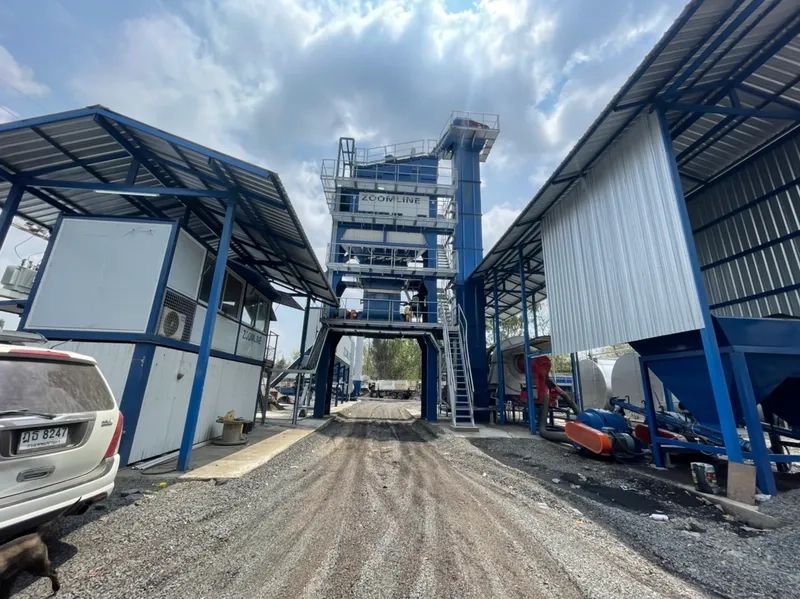
Performance Testing: Long-term Durability Assessment
The quality of asphalt mixtures is not only reflected in their initial performance, but also requires long-term performance testing to assess their durability and ensure the service life of the pavement. Performance testing needs to simulate various deterioration factors during long-term use, analyze the mechanisms of damage, and provide a basis for subsequent design optimization.
Crack resistance and fatigue resistance tests
Cracks and fatigue damage are the main forms of distress in asphalt pavements. Simulation tests are needed to evaluate the crack resistance and fatigue resistance of the mixture to ensure that the pavement remains intact during long-term use.
Cyclic Load Simulation
An asphalt mixture fatigue testing machine was used to simulate the cyclic action of vehicle loads. Cyclic stress levels (typically 50%–70% of the ultimate stress) and cyclic frequencies (10Hz–15Hz) were set to test the fatigue life of the mixture. For asphalt mixtures used on highways, a fatigue life of ≥1 million cycles was required; for Class I highways, ≥800,000 cycles were required. By varying the cyclic stress level and temperature, the fatigue characteristics of the mixture under different service conditions were analyzed, providing parameters for pavement structure design.
Damage Mechanism Analysis
The microstructure of the mixture after fatigue testing was observed using scanning electron microscopy (SEM) to analyze the damage mechanism: if asphalt film separation from aggregate was observed, it indicates insufficient adhesion, requiring optimization of binder performance or addition of anti-stripping agents; if aggregate particle breakage was observed, it indicates insufficient aggregate strength, requiring replacement with high-quality aggregates; if asphalt aging and embrittlement were observed, it indicates insufficient anti-aging performance, requiring the addition of anti-aging agents. Based on the analysis of macroscopic performance indicators and microstructure, targeted improvement measures were formulated.
Verification of anti-rutting performance
Rutting is a major disease of asphalt pavement in high-temperature areas. It is necessary to verify the rutting resistance of the mixture through high-temperature deformation testing to ensure that the pavement remains stable in the high temperatures of summer.
High-temperature deformation test
High-temperature deformation tests were conducted using a dynamic stability testing machine (DS) at 60℃, with a constant pressure of 0.7MPa applied. The deformation of the mixture at different times was recorded, and the dynamic stability (DS value) was calculated. The DS value for the surface layer mixture of highways must be ≥3000 cycles/mm, and for the intermediate layer ≥2000 cycles/mm. For high-temperature areas (annual extreme maximum temperature ≥35℃), the standard needs to be increased to DS ≥4000 cycles/mm for the surface layer. Simultaneously, a wheel rut tester was used to simulate long-term traffic loads and test the permanent deformation of the mixture. The permanent deformation must be ≤2mm/1000 cycles.
Quantification of Stability Indicators
Rutting resistance is quantified into multiple indicators, including dynamic stability (DS), permanent deformation rate (PR), and high-temperature shear strength (HTSS), establishing a multi-indicator evaluation system. For example, the HTSS test is conducted using a dynamic shear rheometer (DSR) at 60℃, and the HTSS of highway mixtures must be ≥1.0 kPa. This comprehensive evaluation using multiple indicators fully reflects the high-temperature stability of the mixture, avoiding the limitations of single-indicator evaluation.
Data Collection and Optimization Feedback
Establish a linkage mechanism between performance test data and design optimization, and continuously improve the design and construction process of mixtures through data accumulation and analysis.
Road Surface Monitoring Network
A long-term monitoring network will be established on existing asphalt pavements, equipped with temperature sensors, strain sensors, displacement sensors, and other devices to collect real-time response data of the pavement under traffic loads and environmental influences. Simultaneously, regular pavement distress surveys will be conducted, recording the location, area, and development rate of defects such as cracks, ruts, and loosening. Monitoring data and distress survey results will be periodically compiled to form a pavement performance database, providing first-hand information for performance evaluation.
Design Iteration and Improvement
Based on long-term performance testing and pavement monitoring data, design iterations and improvements are carried out: if early cracking is found in a batch of mixture in cold regions, the mixture design needs to be optimized, increasing the asphalt content or selecting asphalt with greater ductility; if severe rutting is found in high-temperature areas, the skeleton stability of the aggregate gradation needs to be improved or fiber stabilizers added. The improved design scheme is applied to new engineering projects, and the improvement effect is verified through comparative testing, forming a closed loop of design iteration: “testing—analysis—improvement—verification”.
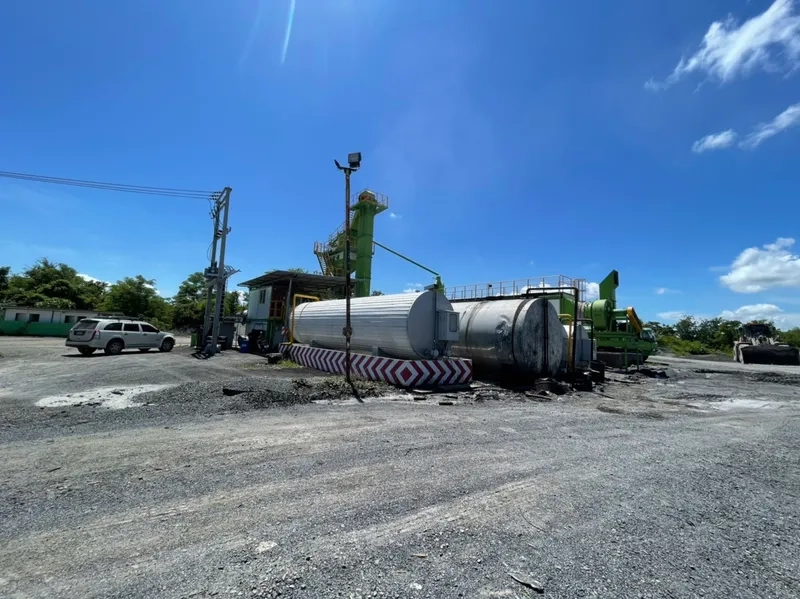
Industry Standards and Certifications: Guarantee of Integrity
Industry standards and certifications are crucial for regulating the production and construction of asphalt mixtures and ensuring quality and integrity. Enterprises must strictly adhere to national and industry standards, actively seek certifications from authoritative bodies, continuously maintain compliance, and establish a reputation for quality and integrity.
National and Industry Standards
National and industry standards are the legal basis for quality control. They must be fully understood and strictly implemented to ensure that every aspect of production and construction meets the requirements of the standards.
Detailed Explanation of Technical Standards
This study delves into core standards such as the “Technical Specification for Construction of Asphalt Pavement on Highways” (JTG F40-2004) and the “Specification for Construction and Quality Acceptance of Urban Road Engineering” (CJJ 1-2008), clarifying the technical requirements for each stage: Regarding raw materials, the standards specify the ranges for indicators such as penetration and ductility of different grades of asphalt; regarding production, the standards stipulate the mixing time (usually 30-50 seconds) and discharge temperature of the mixture; regarding construction, the standards set forth clear requirements for paving speed (2m/min-6m/min) and compaction processes. Enterprises must translate these standards into internal operating manuals and provide specialized training to employees to ensure their effective implementation.
Standardized Testing Methods
Strict adherence to standardized testing methods is maintained to ensure the accuracy and comparability of test results. For example, aggregate gradation testing employs the sieve analysis method from the “Specifications for Testing Aggregates in Highway Engineering” (JTG E42-2005); asphalt performance testing utilizes relevant methods from the “Specifications for Testing Asphalt and Asphalt Mixtures in Highway Engineering” (JTG E20-2011). Testing equipment is calibrated regularly, and testing personnel are certified to avoid testing errors caused by inconsistent testing methods or improper operation, ensuring the authenticity and reliability of test data.
Accreditation by the certification body
Obtaining certification from authoritative organizations is an important proof of a company’s quality strength, which helps to enhance market competitiveness and win customer trust.
Benefits of NAPA Certification
Actively apply for National Asphalt Pavement Association (NAPA) certification, one of the most authoritative certifications in the international asphalt industry, covering the entire process from raw material procurement, production, quality control, and construction techniques. NAPA certification demonstrates that a company’s product quality has reached international advanced levels, which helps in expanding into international markets. Furthermore, NAPA certification requires companies to establish continuous improvement mechanisms, which can drive continuous improvement in the company’s quality control level.
Application of ISO Standards
In addition to ISO 9001 quality management system certification, the company actively applies ISO 14001 environmental management system and ISO 45001 occupational health and safety management system certifications to build an integrated “quality-environment-safety” management system. ISO 14001 certification requires the company to reduce environmental pollution during the production process, such as controlling asphalt fume emissions; ISO 45001 certification requires the company to protect the occupational health of its employees, such as equipping them with asphalt fume protection equipment. Through multi-system certification, the company comprehensively improves its overall management level and establishes a responsible corporate image.
Continuous maintenance of compliance
Compliance is not a one-time achievement; a long-term mechanism needs to be established to continuously track standard updates, conduct compliance assessments, and ensure that companies always remain compliant.
Annual Review Mechanism
Establish an annual certification review mechanism, conducting an internal review once a year during the certification validity period to comprehensively examine the implementation of the quality control system against certification standards and specifications. Invite third-party organizations to conduct annual surveillance audits to promptly identify and rectify compliance issues. Initiate the recertification application process six months before certification expiration to ensure the continued validity of certification. Simultaneously, establish a standard update tracking mechanism to promptly obtain updated information on national and industry standards and revise internal control documents accordingly.
Risk Assessment Integration
Incorporate compliance risks into the company’s overall risk assessment system, identify potential compliance risks in production and construction (such as non-standard raw material inspection, production parameters exceeding standard ranges, etc.), assess the likelihood and impact of these risks, and develop risk response measures. For example, regarding the risk of “new regulations causing existing processes to become non-compliant,” organize technical personnel in advance to study the requirements of the new regulations, adjust production processes, and ensure that rectification is completed before the new regulations are implemented to avoid compliance risks.
Technological Innovation: Future Trends in Quality Control
With the rapid development of science and technology, technological innovation is profoundly changing the model of asphalt mixture quality control. The application of innovative methods such as real-time data analysis, remote sensing, and R&D cooperation will drive quality control towards precision, intelligence, and efficiency, injecting new impetus into quality improvement.
Real-time Data Analysis Tools
Real-time data analysis tools rapidly process and analyze massive amounts of data during the production and construction process, providing precise decision support for quality control and improving management efficiency.
AI-assisted decision-making
Artificial intelligence (AI) technology is applied to quality control to build an AI-assisted decision-making system. By learning from historical quality data and corresponding production parameters, the system establishes a quality prediction model that can predict the performance indicators of the mixture based on real-time collected production data (such as aggregate gradation and asphalt temperature). When the prediction results may exceed the standard range, the AI system automatically proposes adjustment suggestions (such as increasing the amount of asphalt or adjusting the mixing temperature) to assist technicians in making quick decisions. For example, models trained using machine learning algorithms can improve the accuracy of mixture performance prediction to over 90%, significantly reducing testing time and costs.
Big Data Integration Platform
A big data integration platform was built to integrate multi-source data, including raw material inspection data, production process data, on-site testing data, and road surface monitoring data, enabling centralized management and sharing of data. The platform possesses functions such as data cleaning, statistical analysis, and trend prediction, and can uncover the correlations between different data points, providing in-depth evidence for quality improvement. For example, by analyzing the correlation data between raw material moisture content and the compaction density of the mixture, it was found that for every 1% increase in moisture content, the compaction density decreased by 0.5%, leading to the development of stricter raw material moisture content control standards.
Remote Sensing Technology
Remote sensing technology enables remote control of the production and construction process through wireless transmission and real-time monitoring, breaking through the limitations of time and space and improving the coverage and timeliness of quality control.
On-site wireless monitoring
A wireless sensor network is deployed at the construction site. These sensors collect data in real time on paving temperature, compaction, and pavement smoothness, transmitting this data to a remote monitoring center via 5G or IoT technology. Personnel at the monitoring center can view the construction progress in real time, and if the data exceeds standard ranges, they can immediately send warning messages to on-site personnel to guide adjustments. For example, installing GPS positioning and temperature sensors on the paver allows for real-time monitoring of the spatial distribution of paving temperature, enabling timely detection and handling of temperature segregation areas.
Predictive Maintenance Applications
Remote sensing technology is applied to predictive maintenance of production equipment. Vibration and temperature sensors are installed on key equipment such as mixing tanks, conveyor belts, and burners to monitor equipment operating status in real time. By analyzing equipment operating data, potential equipment failures (such as wear on mixing blades or damage to bearings) can be predicted, allowing for advance maintenance and preventing production interruptions and quality fluctuations caused by equipment malfunctions. Predictive maintenance can reduce equipment failure rates by more than 30%, improving production continuity and the stability of mixture quality.
Research and Development and Technical Exchange
Strengthening R&D investment and industry technical exchanges are important ways to promote innovation in quality control technology, enabling companies to acquire the latest technological achievements in a timely manner and enhance their core competitiveness.
Industry Cooperation Projects
We collaborate with universities, research institutions, and industry associations on R&D projects, focusing on key technical challenges in quality control (such as improving low-temperature crack resistance and recycling waste asphalt). For example, we cooperate with universities to research “nano-modified asphalt technology,” which improves asphalt performance and enhances the durability of mixtures by adding nanomaterials; and we collaborate with research institutions to develop an “intelligent paving control system” to automate and refine the paving process. Collaborative R&D can integrate resources from all parties, accelerating technological breakthroughs and the commercialization of research results.
Transformation of Innovative Achievements
Establish a mechanism for the transformation of innovative achievements, enabling the rapid application of R&D results to actual production. Set up a special fund for technology transfer, used for R&D equipment procurement, pilot testing, and employee training; establish a linkage mechanism between R&D and production departments, with R&D personnel participating in the production process and guiding the application of technological achievements; reward R&D teams for successfully transformed innovative achievements to stimulate innovation enthusiasm. For example, after the transformation of the R&D achievement of a “new anti-stripping agent,” the water stability of the mixture increased by 20%, effectively reducing pavement water damage.
Stages and Characteristics of Asphalt Concrete Quality Control
Quality control of asphalt concrete spans multiple stages, each with its unique quality characteristics and key control points. Targeted control measures must be developed based on the characteristics of each stage to ensure overall quality control throughout the process.
Raw material characteristic assessment
The characteristics of raw materials are fundamental to the quality of asphalt concrete. A comprehensive assessment of their physical and chemical properties and compatibility is necessary to ensure that the raw materials meet production requirements.
Physical and Chemical Properties
Physical property assessment includes aggregate particle size distribution, density, and moisture content, as well as asphalt viscosity, penetration, and softening point. Chemical property assessment includes the chemical composition of asphalt, the chemical stability of aggregates, and the chemical compatibility of additives. For example, acidic aggregates have poor adhesion to asphalt, requiring chemical analysis to determine whether anti-stripping agents need to be added; excessive wax content in asphalt can affect low-temperature performance, requiring chemical testing to control the wax content to ≤3%. Comprehensive property assessment provides a scientific basis for hybrid design.
Compatibility Verification
Compatibility verification is crucial to ensuring the synergistic effect of raw materials, requiring testing of the compatibility between aggregates and asphalt, and between asphalt and additives. Dynamic shear rheometer (DSR) is used to test the mixing performance of asphalt and additives, ensuring that the additives are uniformly dispersed in the asphalt; the boiling water method is used to test the bonding performance between aggregates and asphalt, ensuring that the asphalt film firmly encapsulates the aggregate particles. For composite additives, the compatibility between different additives must be tested to avoid chemical reactions that could lead to performance degradation.
Influence of Regional Climate Conditions
Regional climate conditions directly determine the performance requirements of asphalt concrete. It is necessary to adjust the focus of quality control according to local climate characteristics to ensure that the concrete can adapt to environmental changes.
Temperature and Humidity Adaptation
In high-temperature and high-humidity areas, it is crucial to control the water stability and high-temperature rutting resistance of the mixture. High-viscosity asphalt should be used, anti-stripping agents added, and the porosity reduced to 3%–4%. In low-temperature and dry areas, low-temperature crack resistance needs to be enhanced by selecting asphalt with high ductility and increasing the proportion of fine aggregate. In extremely cold areas, the effects of freeze-thaw cycles must be considered, and dense gradation should be used to ensure a freeze-thaw splitting strength ratio ≥85%. Through climate adaptability adjustments, the service life of asphalt concrete can be extended.
Seasonal Adjustment Strategy
Develop quality control adjustment strategies based on seasonal changes: During summer construction, appropriately reduce the discharge temperature of the mixture (e.g., reduce it by 5℃~10℃) and shorten the interval between paving and compaction; during winter construction, increase the heating temperature to ensure that the paving temperature of the mixture is not lower than 140℃, and at the same time, take heat preservation measures to prevent the temperature from dropping too quickly; during rainy season construction, strengthen the monitoring of the moisture content of raw materials, adjust production parameters in a timely manner, and avoid rainwater affecting the performance of the mixture.
Characteristics of Roadbed Construction
The roadbed is the load-bearing foundation of asphalt concrete pavement. The stability and bearing capacity of the roadbed directly affect the pavement quality, and quality control needs to be carried out in combination with the characteristics of roadbed construction.
Basic stability check
The stability check of the subgrade foundation must cover core indicators such as bearing capacity, settlement deformation, and drainage performance to provide a solid guarantee for the paving of asphalt concrete pavement. The bearing capacity is evaluated by heavy dynamic cone penetration test or plate load test. The heavy dynamic cone penetration test requires data to be collected at different depths of the subgrade (each 0.5m is a test point) to ensure that the characteristic value of the foundation bearing capacity is ≥180kPa. The plate load test measures the settlement of the subgrade by applying loads in stages. When the settlement reaches the relative stability standard (settlement ≤0.1mm within 1 hour), the corresponding load is the ultimate bearing capacity of the subgrade, which must meet more than 1.2 times the design requirements.
Settlement deformation inspection is divided into construction period settlement and post-construction settlement monitoring. During the construction period, settlement observation should be conducted after each layer of subgrade filling is completed, using a level to measure the elevation change of the subgrade surface. The settlement amount per instance should be ≤5mm/day. Post-construction settlement monitoring should be carried out continuously for more than 6 months after the subgrade construction is completed. Observations should be conducted once a week for the first 3 months and once every two weeks for the next 3 months. The cumulative post-construction settlement amount should be ≤30mm. If it exceeds the standard, reinforcement treatment should be carried out by replacement filling or dynamic compaction. Drainage performance inspection focuses on the integrity and drainage efficiency of the subgrade drainage system. The subgrade permeability coefficient is tested through water injection tests, requiring a permeability coefficient ≤1×10⁻⁶cm/s. At the same time, the unobstructed drainage facilities such as side ditches and blind ditches are checked to prevent rainwater from seeping into the subgrade and causing a decrease in stability.
Roadbed and pavement co-adaptation
The coordinated adaptation between the subgrade and the asphalt concrete pavement is crucial to ensuring the overall structural stability, requiring control from two aspects: stiffness matching and deformation coordination. Regarding stiffness matching, the ratio of the subgrade resilient modulus to the pavement structural layer modulus is controlled within the range of 1:3 to 1:5 by testing the ratio. If the subgrade resilient modulus is too low (<30MPa), a cement-stabilized crushed stone base course needs to be laid to increase stiffness and prevent stress concentration caused by abrupt changes in pavement stiffness. Regarding deformation coordination, a stress-absorbing layer is installed at the interface between the subgrade and pavement. Using SBS modified asphalt stress-absorbing membrane with an elongation rate ≥500% can effectively absorb the deformation differences between the subgrade and pavement, reducing the generation of reflective cracks.
For areas with soft soil foundations, a specific collaborative adaptation plan needs to be developed, employing CFG pile (cement fly ash gravel pile) composite foundation treatment technology. The pile spacing should be controlled between 1.5m and 2.0m, and the pile length should be determined based on the thickness of the soft soil (it needs to penetrate the soft soil layer and enter the hard soil layer by ≥1m). After treatment, the bearing capacity of the composite foundation should be ≥250kPa. Simultaneously, a geogrid should be laid on the top surface of the roadbed, with a tensile strength ≥80kN/m and an elongation ≤10%, to enhance the integrity of the roadbed, prevent uneven settlement from causing pavement damage, and achieve long-term collaborative stability between the roadbed and the asphalt concrete pavement.
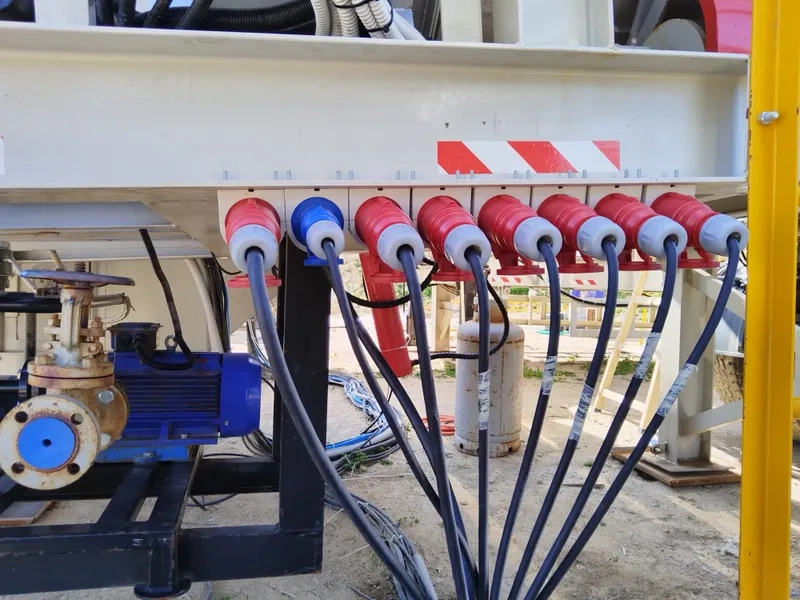
Constructing a full-chain quality control system
Asphalt mixture quality control is a systematic project that spans the entire lifecycle, from raw material procurement and mixture design to production, construction, and post-construction operation and maintenance. It requires a comprehensive, multi-layered quality control system built upon the core principles of “standard-led, process-controlled, technologically innovative, and continuously improving.” From rigorous screening of raw materials to precise optimization of mixture design, from real-time monitoring of the production process to comprehensive verification at the construction site, each link must ensure accountability, standardized procedures, and strengthened collaboration to guarantee that the mixture performance meets project requirements.
With the development of information technology and materials science, innovative methods such as AI-assisted decision-making, remote sensing and monitoring, and novel modified materials are injecting new vitality into quality control, driving the transformation of management models from “post-event remediation” to “pre-event prevention.” Enterprises need to actively embrace technological change, strengthen R&D investment and industry cooperation, and continuously improve the intelligence level of quality control. At the same time, they must strictly abide by national and industry standards, improve certification systems and traceability mechanisms, and ensure quality based on integrity, ultimately achieving the goal of strong load-bearing capacity, long service life, and excellent safety performance of asphalt pavements, providing solid support for the high-quality development of transportation infrastructure construction.




